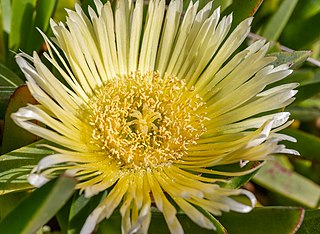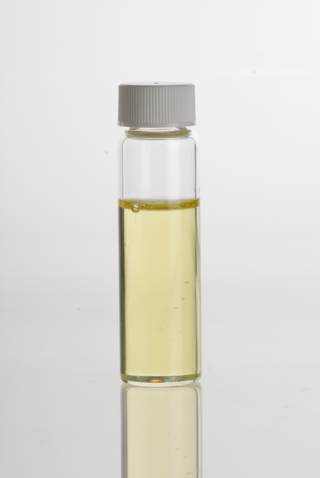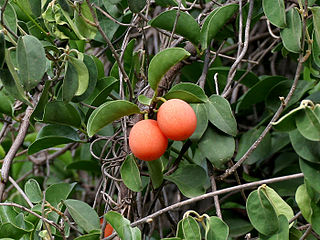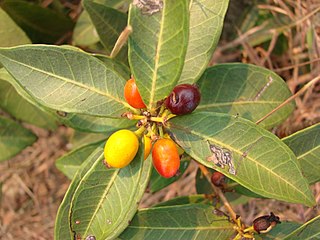
Podocarpus latifolius is a large evergreen tree up to 35 m high and 3 m trunk diameter, in the conifer family Podocarpaceae; it is the type species of the genus Podocarpus.

Sesame is a plant in the genus Sesamum, also called benne. Numerous wild relatives occur in Africa and a smaller number in India. It is widely naturalized in tropical regions around the world and is cultivated for its edible seeds, which grow in pods. World production in 2018 was 6 million metric tons, with Sudan, Myanmar, and India as the largest producers.

Carpobrotus edulis is a ground-creeping plant with succulent leaves in the genus Carpobrotus, native to South Africa. Its common names include hottentot-fig, sour fig, ice plant or highway ice plant.

Sesame oil is an edible vegetable oil derived from sesame seeds. The oil is one of the earliest-known crop-based oils. Worldwide mass modern production is limited due to the inefficient manual harvesting process required to extract the oil. Oil made from raw seeds, which may or may not be cold-pressed, is used as a cooking oil. Oil made from toasted seeds is used for its distinctive nutty aroma and taste, although it may be unsuitable for frying, which makes it taste burnt and bitter.

Sesamum is a genus of about 20 species in the flowering plant family Pedaliaceae. The plants are annual or perennial herbs with edible seeds. The best-known member of the genus is sesame, Sesamum indicum, the source of sesame seeds. The species are primarily African, with some species occurring in India, Sri Lanka, and China. The origin of S. indicum is uncertain, as it is widely cultivated and naturalized in tropical regions. The genus is closely related to the strictly African genus Ceratotheca and is itself probably African in origin.

Pedaliaceae, the pedalium family or sesame family, is a flowering plant family classified in the order Lamiales. The family includes sesame, the source of sesame seeds.

Canarium ovatum, the pili, is a species of tropical tree belonging to the genus Canarium. It is one of approximately 600 species in the family Burseraceae. C. ovatum are native to the Philippines. They are commercially cultivated in the Philippines for their edible nuts and is believed to be indigenous to that country. The fruit and tree are often vulgarized with the umbrella term of "Java almond" which mixes multiple species of the same genus, Canarium.

Ammobium alatum, commonly known as the winged everlasting, is a species of perennial herb in the daisy family Asteraceae and is both a native and an introduced species in south-eastern Australia. It has prominently winged stems, most of its leaves at the base, and heads of yellow florets surrounding by papery, white involucral bracts.
Acroceras macrum is a species of perennial grass native to Africa, which is often cultivated extensively as pasture, silage, and hay. It is palatable and nutritious for animal feed. The roots are extended rhizomes and it produces spiked inflorescences 2–8 cm long. The bright green, lanceolate leaves are typically 8–20 cm long, with the whole plant being about 20–70 cm tall. It has been studied in breeding programs and it has been introduced to Australia and South America for cultivation.

Perilla frutescens, also called deulkkae or Korean perilla, is a species of Perilla in the mint family Lamiaceae. It is an annual plant native to Southeast Asia and Indian highlands, and is traditionally grown in the Korean peninsula, southern China, Japan and India as a crop.

Ximenia americana, commonly known as tallow wood, hog plum, yellow plum, sea lemon, or pi'ut (Chamorro), is bush-forming shrub/small tree; a species from the Ximenia genus in the Olacaceae family. It is mainly found in the tropics, ranging from Africa, India and southeast Asia, to Australia, New Zealand, Pacific Islands, West Indies, Central, North and South America. It is especially common in Africa and South America. It is not domesticated so it is only found occurring in the wild.

Croton gratissimus, is a tropical African shrub or small tree with corky bark, growing to 8 m and belonging to the family of Euphorbiaceae or spurges. Young twigs are slender and angular and covered in silver and rust-coloured scales.

Bauhinia petersiana, the Kalahari white bauhinia, is a species of shrubs from family Fabaceae found in Botswana, Zambia, Democratic Republic of Congo, Lesotho, Mozambique, Angola, Namibia, Tanzania, South Africa, and Zimbabwe. The species is 2 metres in height.

Sesamum radiatum is a species of flowering plant in the Pedaliaceae. It is in the same genus as sesame, and is known by the English common names benniseed, black benniseed, black sesame, and vegetable sesame. It is native to west and central Africa, has been cultivated since ancient times in Africa, and is sometimes also used in tropical Asia where it has become naturalized to a small extent.

Ceratotheca sesamoides is an annual flowering plant in the genus Ceratotheca. It is indigenous to Africa, and grows both as a wild and locally-cultivated species, and is colloquially referred to as false sesame owing to its marked similarities with common sesame. The plant is most commonly cultivated in the African savannah and other semi-arid areas on the continent, and is found across Africa in both tropical and sub-tropical latitudes, usually growing in sandier soils south of the Sahara. It can be identified by numerous hairs on the stem; its pinkish flowers, often showing brown and purple markings; and a sub-erect growth habit. The leaves and flowers are often consumed as a vegetable or used in sauces. The leaves are thought to have medicinal properties, while the seeds can be used to produce cooking oil. Despite its many uses and increasing domestication at a local level, the plant remains predominantly underused and undervalued.

The Chupandia is a tropical species of tree in the sumac family which is found throughout Mexico. It has been cultivated since ancient times, and its edible fruit is still popular in Mexico today. Its bark is used as a substitute for soap. It is a fast-growing tree and can reach a height of 6 meters.
Vachellia kirkii, widely known as Acacia kirkii but now attributed to the genus Vachellia, is a tree native to tropical Africa. It is commonly known as the flood plain acacia.

Eugenia calycina, also known as savannah cherry, field cherry, Jabuti cherry, Grao de galo, cerejinha, cereja de cerrado, pitanga-vermelha, red pitanga, pitanga cherry of cerrado, and ca-ajaboti, is a flowering shrub in the family Myrtaceae. The specific epithet (calycina) comes from Latin calycinus, meaning having a notable calyx.

Pterodiscus is a genus of plant in the Pedaliaceae family comprising several species with a native range from Ethiopia to S. Africa. The range passes through the countries of Angola, Botswana,, Ethiopia, Kenya, Mozambique, Namibia, Somalia, Sudan, Tanzania, Zambia and Zimbabwe. Plus it is found also within the Provinces of South Africa in Cape Provinces, Free State, KwaZulu-Natal and Northern Provinces.
Holubia is a monotypic genus of flowering plants belonging to the family Pedaliaceae. The only species is Holubia saccata.



















